Impact of the Economic Downturn on Not-for-Profit Organisation Management
Attachments
Table of contents
Executive summary
The global economic downturn has resulted in a substantial increase in demand for community services contributing to resourcing pressures for the not-for-profit (NFP) sector.At the same time, many not-for-profit organisations face budget constraints from lower returns on investment funds, tightening corporate budgets and less funding from philanthropic trusts and foundations, major donors and community giving.
With forecasts of slower growth in Australia over 2009 and 2010, the immediate concern for the sector is the impact on unemployment.
As unemployment rises, not-for-profit organisations report an increase in Australians who are under financial stress and seeking support in areas such as emergency relief, employment services, housing assistance, financial counselling and other counselling services. This places further demands on the not-for-profit sector and the services and support it provides - a sector that was facing significant constraints on its ability to deliver services required by the community even before the global financial crisis.
There are some exceptions to this, as it is typically NFP organisations that operate in areas such as health, community support and welfare that are reporting significant demand for services.
However, most NFP organisations report that competition for available funding has increased due to the economic downturn. This has put significant pressure on resourcing in order to continue to deliver services and programs.
This report examines the impact of the economic downturn on NFP operations in Australia. It captures the current impact on funding, services, management of operations, staff and volunteers, as well as the impact on relationships with major donors, philanthropic trusts and foundations, business partners and government. It also looks at expectations for the year ahead and the uncertainty facing many not-for-profit organisations.
This report also includes analysis of quantitative survey research and qualitative focus groups with not-for-profit organisations in Sydney, Melbourne and Perth.
Impact of the downturn on funding for NFP organisations
As a result of the economic downturn, not-for-profit organisations report that funding has declined, and as noted above, competition for available funding has increased.To make up for funding shortfalls, NFP organisations are cutting costs, expanding their fundraising efforts and looking for innovative ways to increase fundraising. They are also utilising reserve funds to cover any shortfalls.
There have been announcements of staff cutbacks in the sector. However, many of the NFP organisations that we consulted say they are looking for ways to manage without significant employee reductions.
Our survey results indicate that the biggest falls in funding have been from investment income, corporate funding and funding from major donors, philanthropic trusts and foundations. Three-quarters of those surveyed report a decrease in investment income in the 2008/09 financial year.
The extent of decline in corporate funding depends on the nature of the NFP-business relationship. Multi-year partnerships appear to be stable and mostly rolled over, whereas one-off funding support in response to ad hoc requests or in areas such as sponsorship of arts or sports, appear to be most at risk. These issues are discussed further in a complementary report undertaken by the Centre for Corporate Public Affairs (2009) entitled, Impact of the Economic Downturn on Corporate Community Investment.
Some NFP organisations also report that funding for diaster relief efforts, such as the Summer 2009 Victorian bushfires, has diverted funding away from their activities.
On the other hand, some NFP organisations have reported stronger-than-expected financial results in the last year. For these organisations, the economic downturn has resulted in a surge in demand for services and support associated with the global financial crisis, favourable publicity, and increased awareness, that has resulted in an overall increase in financial support. However, these are the exception rather than the norm.
There appears to be appreciation within the sector of the role of governments in assisting NFP organisations provide funding to meet demand for important services, as well as more broadly in terms of stimulus package payments to assist Australians during the economic downturn.
Some not-for-profit organisations report that they have applied for Temporary Financial Assistance Funding, while our survey indicates that some 32 per cent of NFP organisations have seen an increase in funding from government grants in the 2008/09 financial year.
2010 is expected to continue to be a challenging one for NFP organisations. They anticipate further decreases in investment income and funding from companies, major donors, philanthropic trusts and foundations. Nearly 40 per cent of NFP organisations surveyed expect an increase in government funding. A third expect fundraising to increase in areas such as regular giving, online donations and event fundraising.
Increased demand for community services
As noted earlier, our consultations and survey research illustrate the significant increase in demand for many services provided by NFP organisations. Sixty-five percent of not-for-profits surveyed report an increase in demand for services as a result of the economic downturn, and 83 per cent expect an increase in demand for services in the next financial year (2009-2010).For example, organisations such as The Salvation Army, which each year assists over one million Australians in crisis, say they expect to continue to see an increase in demand for their services in 2009 and 2010.
In particular, not-for-profit organisations that provide services in areas such as financial assistance and counselling, employment services, food and emergency relief, housing support, counselling and relationship support are reporting a significant increase in demand for services as a result of the economic downturn. This puts greater strain on many NFP organisations, particularly those in the welfare area. Over one third of these organisations surveyed as research for this report indicate that they have had to reduce services as a result of the economic downturn.
Management of not-for-profit operations
Despite the challenges facing the sector, the majority of not-for-profit organisations are maintaining their focus on core mission and priorities. Eighty-three per cent of NFP organisations surveyed say they are focusing on core business aligned with their mission.NFP organisations also report that they are concerned about managing the financial impact of the downturn on their operations. Seventy-seven per cent state they are reducing costs. Some of this is taking place in staffing levels, with reduction of staff hours, redundancies, not replacing staff when they leave, or a move to rely more on part-time or volunteer staff. In other areas, administrative costs, outsourcing (NFPs are looking to do more in-house) and travel are all under review. Some NFP practitioners note that they already operate lean budgets, therefore a cost review has been difficult.
While there have been some changes to staffing levels, for the most part NFP organisations report no major changes to levels of full-time, part-time or volunteering employees.
Where there have been changes to staff numbers, this appears to be a result of changes to fundraising approaches, or due to a review of fundraising.
Anecdotal evidence suggests that the number of people who are volunteering is increasing, due to redundancies and unemployment. Our survey shows that 28 per cent of NFP organisations report an increase in volunteers in the 2008/09 year.
Thirty-five per cent expect an increase in volunteers in the 2009/10 financial year. This suggests there may be a lag effect from actual redundancies to the pick up in availability of volunteers. Volunteer organisations report strong demand for volunteer opportunities as a result of the economic downturn.
Not-for-profit employees are spending more time managing relationships with major donors and partners, and working closely with their Boards to manage uncertainties. NFP employees are also spending more time on marketing to increase awareness of the issues their organisation addresses, as well as to differentiate them from peer organisations.
There is greater appetite for collaboration within the not-for-profit sector as a result of the downturn.
In order to meet growing demand for services, NFP organisations are collaborating or rationalising services with other peer organisations. Our survey concludes that nearly half of NFP organisations are considering some means of collaboration.
Some NFP organisations are also considering mergers (15 per cent of those surveyed), however, it is difficult to ascertain whether this trend is due to the economic downturn or was occurring regardless of the downturn. Traditionally, there have not been many mergers in the sector so this may be an area to watch over the next year.
Relationships with major donors, corporate partners and government
NFP organisations report that they are spending more time managing relationships with their partners. NFP practitioners we spoke to during consultations say they are having 'open and honest' conversations with their partners about the impact of the downturn on each others' businesses.NFP organisations with long-term partnerships or sophisticated relationships with business, major donors and trusts and foundations, report that most of these agreements and contracts are being renewed. However, NFP organisations are concerned about whether these will be renewed over the next few years.
NFP organisations agree that the priorities of companies, major donors and philanthropic trusts and foundations are changing. Many of their partners are evaluating relationships and revisiting long-term understandings and agreements.
There appear to be more issues to manage within partnerships or major relationships. NFP organisations say that their partners are placing more demands on them, particularly on requirements for measuring outcomes, and more information on the benefits of the relationships.
Not-for-profit organisations describe some changes in the nature of corporate support, from less untied cash to more support in community activities, marketing related sponsorship and corporate volunteers. NFP organisations understand that many companies cannot be seen to support events such as a charity ball, when they may be making tough business decisions such as redundancies in their own organisations.
While the changes in nature of support have been exacerbated by the economic downturn, they also reinforce the trend that was already occurring, of companies reducing their untied support and focusing on fewer, deeper partnerships supported by a range of measures including in-kind support, volunteer activities, as well as funding for programs.
Some philanthropic foundations are scaling back commitments and reducing discretionary or one-off grants. In particular, NFP organisations report that US-based foundations are reviewing commitments more so than Australian foundations.
The capacity of some major donors, philanthropic foundations and trusts to provide funding support has also been reduced as a result of declines in their own investment income. Despite this, we understand that some individual philanthropists have increased support as they recognise that needs are greater during an economic downturn.
As already noted, NFP organisations are appreciative of government funding to support them during the economic downturn. They report that they are spending more time communicating with government, including through meetings and increased reporting.
There are a number of characteristics of sustainable relationships, which will assist in weathering this economic downturn and any future downturns. NFP organisations that have relationships that are sustainable typically communicate more frequently with their partners; build deeper and broader links with contacts; have formal longer-term contracts that cover mutually agreed goals, governance, decision making and other issues of importance; have more diverse relationships across various sectors; have deep connections to communities and are willing to collaborate with other organisations to deliver services.
Opportunities arising as a result of the economic downturn
Not-for-profit organisations identify a number of positive impacts of the economic downturn, including an increased focus on good governance and management of risks and reserves, as well as opportunities for increased engagement with Boards on financial management and strategy planning.There are also opportunities to raise awareness of issues such as homelessness, and as one NFP practitioner explained, 'to leverage and maximise the real value of the sector to the community'.
A small number of not-for-profit organisations are looking at expansion possibilities as the result of increased demand for services. The downturn also creates opportunities to strengthen relationships with current partners as well as refocus activities and programs. In recent years, the NFP sector has found it difficult to recruit skilled staff. The economic downturn has provided some opportunity to access skilled employees. These opportunities are discussed later in this report.
Chapter 1 Introduction
1.1 Background to project
The Department of Families, Housing, Community Services and Indigenous Affairs commissioned the Centre for Corporate Public Affairs to undertake research into the impact of the current economic downturn on the operations of not-for-profit community organisations.This follows a report completed in 2008, Relationship Matters: Not-for-profit community organisations and corporate community investment,which included input from about 200 not-for-profit (NFP) organisations via survey, workshops and interviews.
1.2 Project objectives
This research provides a snapshot of the magnitude of the impact of the economic downturn on the operations of not-for-profit organisations.Our analysis focused on the following research questions.
- How is the global financial crisis and resulting uncertainty (including increased demand for services, reduced funding) impacting on not-for-profit operations, such as reducing costs/staff, reducing or holding off new services, collaborating/rationalising with peer organisations, and running down reserves?
- What impact will the economic downturn have on existing and potential community business partnerships, including delivery of services, sources of support (community activities, sponsorships, cause related marketing, volunteers, workplace giving), funding streams, and achievement of societal outcomes?
- What are the experiences, current and anticipated, of not-for-profit organisations in managing relationships with major donors, business and philanthropic partners?
- What are the impacts, if any, on the nature and direction of NFP priorities and activities?
- What opportunities can arise from the economic downturn?
1.3 Methodology
The study incorporates research from three sources - an online survey of not-for-profit organisations, select consultations with NFP organisations through focus groups and individual phone consultations.The consultants also reviewed relevant research from the Victorian Department of Planning and Community Development, as well as recent reports prepared for VCOSS and a consortium of NFP organisations.
Online survey
The Centre developed and managed an online survey of Australian not-for-profit organisations to capture the views of a broad range of organisations. The online survey was open between 20 May and 10 June 2009.
The survey was distributed to more than 700 not-for-profit organisations. Seventy-three NFP organisations completed the online survey.
Figure 1.1 illustrates the range of activities of those not-for-profit organisations that participated in the survey. Most respondent organisations work in activities related to health, youth, education and training, children and child welfare. Note that respondents were able to choose multiple categories.
Figure 1.1: Classification
 Source: Centre for Corporate Public Affairs, Survey of NFP organisations 2009. Survey respondents were asked to nominate areas of principal activity. More than one category may apply. N=64.
Source: Centre for Corporate Public Affairs, Survey of NFP organisations 2009. Survey respondents were asked to nominate areas of principal activity. More than one category may apply. N=64.
Nearly 40 per cent of organisations surveyed employ 0 to 9 full-time staff. Thirty-seven per cent employ 10 to 49 full-time staff. Two-thirds of not-for-profit organisations surveyed employ less than 10 part-time staff.
Figure 1.2: Employment Demographics
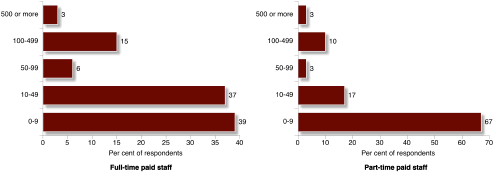
Source: Centre for Corporate Public Affairs, Survey of NFP organisations 2009. N=66.
Figure 1.3 illustrates that nearly a third of organisations surveyed have large numbers of volunteers working in them (between 100 and 499 volunteers). Eleven per cent of not-for-profit organisations surveyed have more than 500 volunteers.
Figure 1.3: Volunteer Demographics
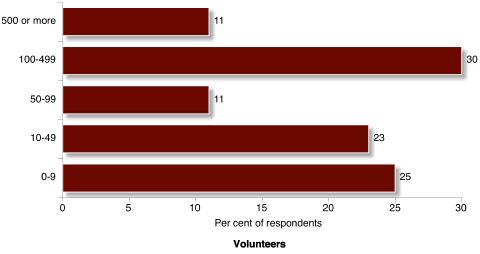
Source: Centre for Corporate Public Affairs, Survey of NFP organisations 2009. N=66.
About half of the not-for-profit organisations surveyed derive a substantial part of their cash incomes from government sources (50% or more of their cash incomes).
According to the Centre's previous research (Centre for Corporate Public Affairs, 2008), a substantial proportion of this government support appears to be funding for delivery of government programs and services. We note that there may be a higher proportion of government-funded NFP organisations represented in this study, compared to ABS data. In the 2006-07 financial year, government funding accounted for 33.5 per cent of funding to NFP organisations (ABS 2009).
Figure 1.4: Sources of cash Income
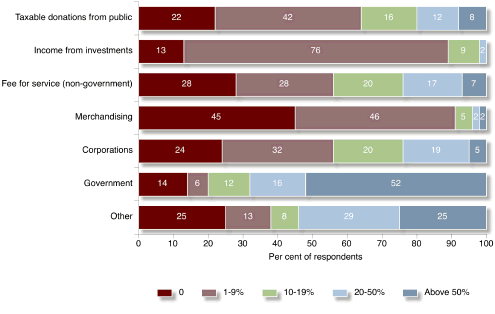
Source: Centre for Corporate Public Affairs, Survey of NFP organisations 2009. N=66.
The not-for-profit organisations surveyed have activities and operations across Australia. Nearly one third were national not-for-profits. Just under 30 per cent had activities/operations in Western Australia, and a slightly lower number had activities/operations in New South Wales and Victoria. Not-for-profit organisations with activities or operations in Queensland, ACT, South Australia Tasmania and Northern Territory also participated in this survey.
Consultations with not-for-profit organisations
For the purposes of this research, the Centre for Corporate Public Affairs convened small participant focus groups in Sydney, Melbourne, and Perth. Twenty-five not-for-profit practitioners attended the focus groups. Additionally we spoke to a small number of practitioners who were unable to attend the focus group but who wanted to provide input to this report.
The discussions and insights from the focus groups are reported and cited in this study.
Chapter 2 Impact on not-for-profit operations
2.1 Overview
Not-for-profit organisations that were consulted for this project noted increased demand for services (particularly those that operate in emergency accommodation, family services, unemployment support and other welfare areas), and significant falls in funding as a result of the economic downturn.Many are facing budgetary constraints and focusing on cost cutting, expanding fundraising activities or looking at more innovative fundraising initiatives to make up the short-fall. There have been redundancies in the sector, and some of the work undertaken by full-time practitioners has shifted to part-time or volunteer staff. There continues to be pressure on NFP organisations to provide volunteer opportunities for the community, and some are looking at different ways they can take advantage of the increase in available volunteers.
Overall, NFP organisations appear to be maintaining a focus on their core mission and reviewing services and activities where cuts can be made. Many not-for-profit organisations report that they already have very lean budgets, so finding areas in which to cut funding has been difficult.
Not-for-profit organisations are drawing down on reserve funds as well as reviewing non-essential areas and programs that can be cut or deferred. As a result of the downturn, there appears to be more collaboration in the sector as NFP organisations look for new ways to deliver their services.
These findings are consistent with research (see Box 2.3 on page 28) conducted by the Victorian Department of Planning and Community Development (2009a).
2.2 Funding of not-for-profit organisations
For many not-for-profit organisations, the economic downturn has had a severe impact on their funding.Overall, it appears that investment incomes have fallen, funding from companies and major donors has been cut and regular giving and fundraising has been harder to attract.
The following comments from NFP practitioners illustrate this:
All parties (government and private) have withdrawn support for the charitable sector to a large degree.There are some exceptions to this. For example, some not-for-profit organisations have been beneficiaries of disaster relief funding, including those affected by the recent Victorian bushfires and Queensland floods.
Withdrawal of major and minor sponsorships has put severe restraints on our operation.
Corporate freeze on sponsorships for the next fiscal period has a big impact. We are appealing to individuals and small community groups instead, to try to meet our targets and maintain operational funding.
Also, some organisations have been beneficiaries of additional funding that has been provided to assist meet specific surges in demand for services. Others report that they have experienced favourable publicity and increased awareness during these difficult times, which has improved their support base and therefore donations to their organisation.
These appear to be specific exceptions however. On the whole, many not-for-profit organisations are stretched to meet demand for services in an environment where funding has been significantly reduced.
In relation to corporate funding, the impact has been varied according to sectors and the nature of relationships with NFP organisations. Multi-year corporate partnerships (and their associated funding) appear to be stable, although some acknowledge that these may still be tested in the year ahead.
Many not-for-profit organisations report that larger companies in particular are taking a long-term approach and are renewing their partnership and funding commitments.
In an open-ended question in our survey, some not-for-profits highlighted the likelihood of reduced business funding:
The financial downturn has meant less likelihood of corporate sponsorship.Not-for-profit organisations in Western Australia in particular note that they have enjoyed the benefits of a resources boom and associated increased community investment funding from many mining and resources companies over the past few years, and that this is likely to now change. As one NFP commented:
We rely on the generosity of corporate sponsors and this is rapidly evaporating.
In WA, mining companies are closing down - the bust is upon us.Some not-for-profit organisations also report that arts and sports programs and activities are areas in which companies appear to be cutting back.
A survey of 39 companies conduced by Australia Business Arts Foundation (2009) in May 2009 found that arts sponsorships are expected to see a sharp decline this year, particularly towards the end of 2009 and beginning of 2010. It expects that companies that provide more than $500,000 in funding and those that provide less than $50,000 are more likely to decrease their sponsorship.
Companies report that they want more value from their relationships. Half of companies surveyed say they are likely to substitute cash support with provision of in-kind product or pro bono services. As stated in the survey findings:
...partnerships are more vulnerable to being reduced or cut when they are based not on long-term strategic alignment (including CSR), brand or staff objectives but on short-term tactical considerations, especially where motivating factors include hospitality benefits and personal interests of management. (AbaF 2009).Another area of expected decline in corporate funding is in matched giving, with some NFP organisations reporting that companies are putting caps on matched giving or reducing their existing caps.
While payroll giving itself appears to be maintained (or at least we were not aware of specific instances of major declines in this area), the amount contributed by some companies to NFP organisations has declined due to the matched funding component.
Global philanthropic foundations - more so than Australian foundations - are reviewing their relationships and reducing commitments, adding to funding pressures.
Social enterprises are also under pressure and falling contributions lead to reduced incomes for some NFP organisations.
And finally, some government funding is coming to an end, or expected to be under threat, though it is not clear to what extent this is attributable to the downturn. This is illustrated by the following comments from NFPs:
All of our current State and Federal Government funding is one off for specific projects and programs. Local Government provides a small amount of ongoing funding. This funding could be under threat as the economic downturn bites in the area due to job losses in the region.While some NFP organisations have received increased funding for disaster relief, other organisations report that funding allocated to emergency disaster relief has resulted in a redirection of funds away from supporting their activities. Some NFP organisations attending our focus groups indicated their corporate supporters had less community funding available because of increased contributions to diaster relief in the first half of 2009.
Goernment funding is insecure with budget cuts.
Research undertaken with Victorian NFP organisations also found that there was some redirection of funding - see Box 2.3 (Department of State and Community Development, 2009b). It is difficult to assess the exact redirection of funds.
There was mixed feedback on the impact of the downturn on general philanthropic giving. Some have experienced significant decreases, while others have maintained regular giving and donations. On balance it appears that community giving has remained robust through the downturn to date.
Some NFP organisations indicated they are looking to governments to assist, and have applied for additional emergency funding. In our survey, 11 respondents said they had applied for additional funding, mostly from the Temporary Financial Assistance Funding as part of the Jobs Fund (applications were due in late-May 2009).
Current impact on funding
According to our survey results, the biggest falls in not-for-profit organisation income appear to be from investment incomes, corporate funding and funding from major donors, philanthropic trusts and foundations (see Figure 2.1).As a result, reserve funds have decreased as organisations run down reserves to cover funding shortfalls. Borrowings have remained largely unchanged. Ninety per cent of survey respondents reporting no change in this current financial year, compared to last year.
Figure 2.1: Current Impact of the Economic downturn on Not-for-Profit Financial Operations
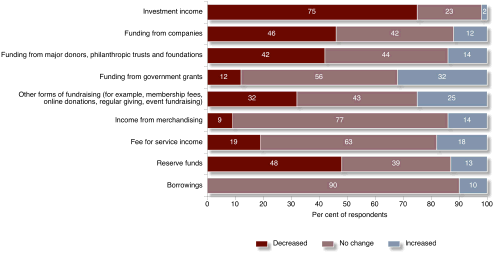
Source: Centre for Corporate Public Affairs, Survey of NFP organisations 2009. Comparison of this financial year (2008/09) with last financial year (2007/08). N=70.
Figure 2.2 shows the proportion of increase or decrease for the 2008/09 financial year and the 2009/10 financial year.
Figure 2.2: Proportion of Increase or Decrease
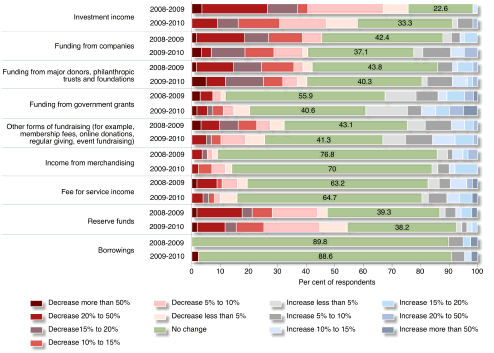
Source: Centre for Corporate Public Affairs, Survey of NFP organisations 2009. N=70.
As a result of reduced funding, many NFP organisations are anticipating a deficit in the 2008-2009 financial year (ending 30 June 2009). Forty per cent of survey respondents expect a deficit in the current financial year, while 11 per cent say they are expecting a deficit but that this is a normal result, not related to the economic downturn.
Of those that expect an operating deficit, the vast majority surveyed indicated they would be running down reserves in order to finance the deficit and enable them to continue to deliver services and pay staff. Others are considering reducing staff costs, reducing or deferring services, reducing overheads and cutting expenditure. Some of the comments from NFP practitioners include:
[We are] cutting services and selling assets.
We will have to run down reserve funds unless current funding levels are increased.
We are a small organisation depending on very small government grants and memberships. If we lose either of these - we may have to close.
[We are] running on reserve funds unless alternate funding can be found. Possible complete shutdown of [our] service, leading to increased youth anti-social behaviour, crime, etc.
We don't have high levels of [reserve funds, assets etc] which are negotiable. We will save wherever possible and try to gain more in-kind or pro bono goods and services to make up the deficit.
Services will be decreased to not incur a deficit. Staff will be made redundant.
Expectations of funding in the year ahead
Over the next financial year, many NFP practitioners expect that funding will continue to be a challenge. Significant decreases are expected in investment incomes, reserve funds, funding from companies and funding from major donors and philanthropic trusts. Nearly 40 per cent expect an increase in government funding, and a third expect income from other forms of fundraising to increase in 2009-2010.Figure 2.3: Expectations for the Next Financial Year (2009-2010)
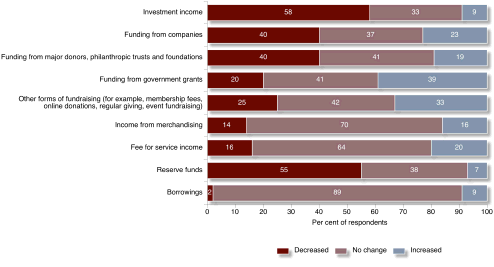
Source: Centre for Corporate Public Affairs, Survey of NFP organisations 2009. N=70.
Figure 2.2 indicates the proportion of increase or decrease expected over the next financial year.
In another question about expectations for the next financial year, 40 per cent of survey respondents anticipated a deficit as a result of the economic downturn.
Shift from funding support to in-kind support
Not-for-profit organisations report that there has been a significant shift from cash support to in-kind support, particularly from companies that have food and clothing product.In response to our survey, 41 per cent of NFP organisations report that there has been an increase in in-kind support for their organisation. Thirty-three per cent expect an increase in in-kind support over the next financial year.
One NFP described it thus:
There appears to be a shift toward in-kind giving. One of our major sponsors will not be continuing with their financial support of the foundation next year but they have offered ongoing support in other ways - for example, financial literacy training for young people - this is very valuable so we are glad this is still on the table.While a reduction in monetary support places pressure on budgets, NFP organisations in consultations expressed the view that they were generally grateful for any support and most importantly, appreciative of the continuation of relationships.
2.3 Management of not-for-profit operations
Not-for-profit organisations appear to be maintaining focus on their core mission and priorities and the economic downturn has had no significant impact on this. There are some changes in the nature of fundraising activities and NFP organisations report that they need to be more innovative in the way that they fundraise during this tougher economic environment.During consultations, one large NFP commented that it had significant success in the 2008-2009 financial year by focusing on internet-based fundraising rather than traditional mail-outs. Through this, it had managed to access a 'new generation' of giver. Others are seeking ways to expand their donor bases to access new sources of funding.
When asked whether priorities have changed as a result of the downturn, survey respondents' views were mixed.
Some NFP organisations were reducing costs, reducing services and putting expansion plans on hold. Others were more focused on looking at new ways to raise revenue, through for example, more fee-for-service work or through greater marketing and advocacy.
One NFP practitioner mentioned their organisation was considering consultancy work and alternative sources for project work. Another NFP practitioner said they that had examined other possibilities, including developing a business plan for a social enterprise and considering amalgamation with another organisation.
A large number, however, reported they were focusing on core business, and were attempting to streamline and focus activities. The following comments from NFP practitioners reinforce these views:
We will stick to core business - and we will be able to offer much less on current funding levels.As Figure 2.4 illustrates, 83 per cent of organisations surveyed report that they are focusing on core business aligned with their mission. Only seven per cent disagree with this statement.
[We have a] greater focus on service delivery, core functions and the option of charging for some services that are additional to generate revenue.
We are sticking to the basics and what has historically worked for the most part, with one major pilot initiative which we will test on a very small scale before deciding to go large. Events will also become more simple and affordable by the majority, with more in-kind and donated elements.
Increased demand, especially from remote communities has opened up opportunities for [our organisation] to further increase the range of services provided to assist those in need within the community.
Figure 2.4: Core Business
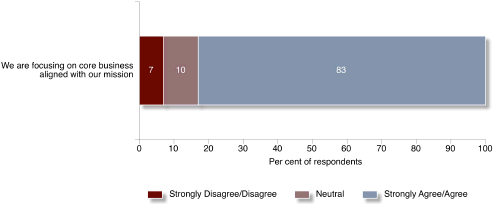
Source: Centre for Corporate Public Affairs, Survey of NFP organisations 2009. N=71.
As highlighted Section 2.2, NFP organisations are concerned about managing the financial impact of the downturn on their operations. In many instances, this means an emphasis on further reduction of costs and in some instances, running down of reserves to cover operating expenses. Sixty-seven per cent of survey respondents said they were concerned about managing their financial situation - illustrated in Figure 2.5.
Not-for-profit organisations are seeking to cut expenses and are reviewing costs associated with programs and activities. Seventy-seven per cent of survey respondents say they are reducing costs as a result of the economic downturn. Eighty-four per cent say that competition for available funds has increased.
About 40 per cent of NFP organisations surveyed say they are reviewing their investment policies, following falls in investment income. As well as the impact of lower asset values and dividend income on investment income, we understand that some NFP organisations are looking to tighten their investment policies and reassessing risk levels following adverse effects of higher risk investments over the past year.
Not only are NFP organisations facing less funding, but they also report delays in receiving funding - 62 per cent of organisations surveyed say they are facing increased delays. This appears to be a result of major donors, companies, philanthropic trusts and foundations undertaking reviews of their funding commitments as a result of the economic downturn. We also understand that some companies that have three-year agreements are looking to phase the funding commitments towards the end of the agreement period, which is also resulting in delays in funding for some organisations.
Figure 2.5: Actions Taken during Economic Downturns
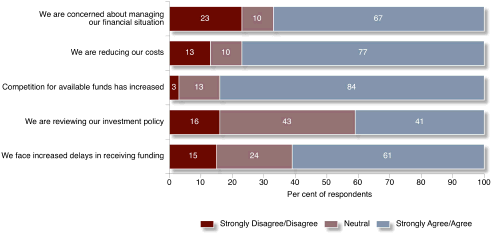
Source: Centre for Corporate Public Affairs, Survey of NFP organisations 2009. N=70.
Not-for-profit organisations are cutting costs in a variety of ways, in particular by reducing staff costs either by reducing staff hours, making staff redundant, or not replacing staff that leave. Some NFP organisations are also curtailing training and professional development opportunities for their staff. This is discussed further in Section 2.5.
Cost-cutting is also taking place in areas such as administration, outsourcing (more is being done in-house) and travel. One NFP practitioner commented: 'We are paying greater attention to use of technology to minimise costs.' Another NFP said it was cutting costs such as the annual report and other 'nice to have' areas.
A number of NFPs commented that they already operate with very lean budgets and with minimal staff expenses, so it was difficult to find areas to reduce costs.
NFP organisations are seeking to do 'more with less' and note that they are spending more time in managing relationships (66 per cent of NFP organisations agree) and working with their Board to manage uncertainties (84 per cent of NFP organisations agree).
Figure 2.6 also illustrates that NFP organisations are spending more time marketing, and looking to increase fundraising campaigns because of the economic downturn.
Figure 2.6: Impact of the Economic Downtun on Management of NFP Operations
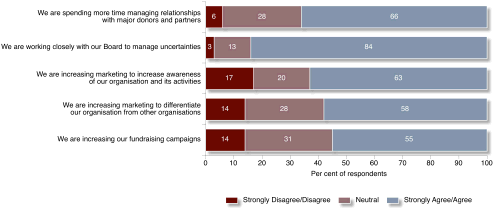
Source: Centre for Corporate Public Affairs, Survey of NFP organisations 2009. N=70.
Collaboration with peer organisations
There appears to be more collaboration underway in the NFP sector, particularly since survey research for the Centre's previous report Relationship Matters: not-for-profit community organisations and corporate community investment (October 2008).While not-for-profit organisations report an increase in collaboration as a result of the economic downturn, there are also other mergers and collaboration in discussion, and some were underway before the advent of the global financial crisis.
Fifteen per cent of NFPs surveyed say that they are merging or considering a merger as a result of the economic downturn (see Figure 2.7).
The Centre understands that in a faith-based charitable umbrella group, up to five of the 30 organisations are in merger discussions as a result of resource pressures exacerbated by the economic downturn.
Undertaking a merger will require management time and additional funding. Peter de Courcy Hero of Melbourne Community Foundation suggests that an economic downturn is not the ideal time to undertake a merger, and that requires NFP organisations to invest in their capacity to manage this change, something that not many donors are likely to fund (Lea 2009).
In undertaking research for this report, we are aware of one corporate foundation providing funding to support a merger between not-for-profit organisations.
It is more likely that NFP organisations are collaborating or rationalising with other peer organisations to provide services. Nearly half of NFP organisations surveyed agree they are collaborating to provide services. Companies in particular, are likely to be encouraged by an increase in collaboration, as a common criticism has been that the NFP sector has 'too many organisations focused on the same areas'.
It is less likely that NFP organisations will be outsourcing during the downturn (as noted previously). Nor are they likely to be relying on intermediaries and broking organisations to assist find new opportunities. One quarter of NFP organisations surveyed said they are seeking the support of peak NFP organisations. These are more likely to be smaller NFP organisations that rely on brokers and peak bodies for expertise, and are more likely to 'outsource' due to their own capacity constraints.
A recent survey of 18 Victorian NFP organisations also illustrated this collaborative trend. Sixty-five per cent report that they were considering collaborative approaches with other peer organisations (Department of Planning and Community Development 2009a). [Note, see Box 2.3 for a summary of this research].
Figure 2.7: Collaboration
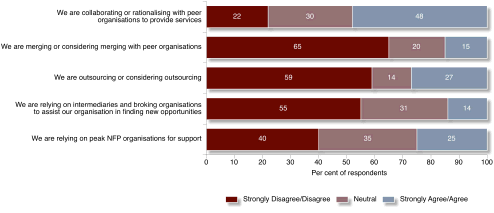
Source: Centre for Corporate Public Affairs, Survey of NFP organisations 2009. N=70.
2.4 Demand for services
One of the major impacts of the downturn on not-for-profit organisations is their capacity to meet the substantial increase in demand for services, while managing funding constraints. Sixty-five per cent of respondents to our survey say their organisation has experienced an increased in demand for services as a result of the economic downturn. As one NFP commented:With the economic downturn we have seen a sharp rise in demand for our services, yet we have no new resources to cope with this.Eighty-three per cent expect the increase in demand for services to continue in the next financial year.
When asked to quantify the increase, a third of respondents say the increase has been up to 15 per cent, a third say the increase has been between 15 and 20 per cent, and just under a third say the increase in demand for services as been in the range of 20 to 50 per cent. One respondent said the increase has been more than 50 per cent.
These increases suggest quite substantial changes in the demand for NFP services. Figure 2.8 illustrates the proportion of increase or decrease in demand for services in the current financial year and the next financial year.
Figure 2.8: Proportion of Increase of Decrease in Services
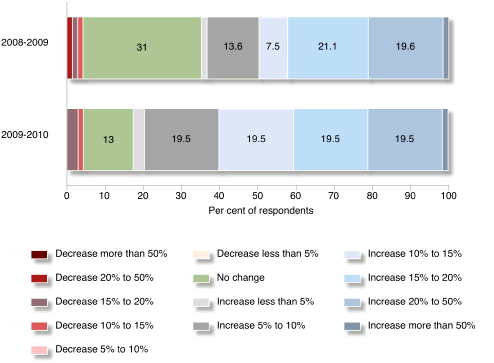
Source: Centre for Corporate Public Affairs, Survey of NFP organisations 2009. N=70.
A report prepared for Anglicare Australia, Catholic Social Services Australia, The Salvation Army and UnitingCare (Access Economics 2008) found that the global financial crisis would put community service organisations under even greater strain than currently predicted based on demographic trends.
In particular, the impact of the global financial crisis on the Australian economy is predicted to have an acute impact on some of the most disadvantaged people in the community - pushing increasing numbers of low and middle income earners to seek the services of welfare agencies. This in turn will put an even greater strain on what are already overstretched social services.
The greatest increases in demand will most likely be for:
- employment services - assisting the unemployed find jobs;
- housing services - assisting those who can no longer afford to pay rent, or those who cannot afford to pay their mortgage to find alternative accommodation;
- financial counselling services - providing financial advice to those who, for example, may have incurred large debts;
- emergency relief services - short-term assistance through the allocation of food parcels, food and other vouchers; and
- counselling services - helping people deal with long-standing or sudden problems or changes in circumstances (Access Economics 2008).
The recently released Australian Community Sector Survey 2009 (ACOSS 2009) illustrates further that demand for support and services in areas such as housing, crisis accommodation, mental health, drug and alcohol services, income support, aged and disability services, and education, employment and training programs have increased over the last financial year.
This survey found that some community services organisations are at 'breaking point' and having to turn away people.
While this survey was conducted prior to the global financial crisis, ACOSS (2009, p.2) reports that 'With organisations already reporting stretched resources and increasingly unmet demand for services, increased unemployment alone is likely to see organisations' capacity to meet this demand significantly compromised.'
Our consultations found that not-for-profit organisations that provide services in particular areas such as financial assistance, housing, counselling and relationship support are seeing an increase in demand for these services.
The demand for food distribution, especially in regional areas has also seen a sharp increase. While some areas such as food distribution and school breakfast programs appear to be well positioned to attract additional funding to support the increase in demand, there are many other areas that were already under pressure, including counselling, where NFP organisations are finding it difficult to cope with the rapid increase in demand for services.
As one mental health care practitioner stated:
The recession is adding greater strain to the already alarming and frightening youth suicide, depression, anxiety and wellbeing statistics.Other NFP practitioners noted:
The major impact the downturn is having on [our organisation] is the lack of opportunity to provide services to Indigenous people requesting our services. We know these people are in dire need...but we have little or no funding for these areas.
Because we provide services to disadvantaged including the unemployed, our services are increasing.
Despite the challenges in managing the demand for services, most NFP organisations are not reducing their services (58 per cent) but are finding ways to still deliver their core services. It is still significant that 35 per cent of NFP organisations say they are reducing services as a result of the economic downturn (see Figure 2.9).
Where the impact is mainly being seen is in terms of delivery of new services. Nearly 60 per cent of those surveyed state that they are holding off on new services. Twenty-eight per cent are diversifying and tendering for services that are outside of core business.
Figure 2.9: Impact on Services
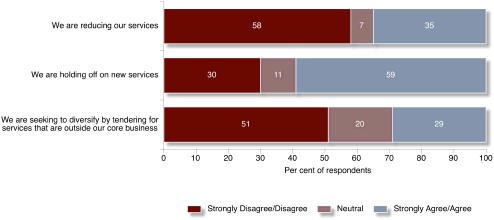
Source: Centre for Corporate Public Affairs, Survey of NFP organisations 2009. N=71.
An earlier research report also highlights this increase in demand for services. In October 2008, the Allen Consulting Group undertook a survey on behalf of the Victorian Council of Social Services (VCOSS) on funding and service requirements.
Survey participants were asked whether they thought demand for their services was likely to increase in the next year or two. The vast majority of respondents said they believed that it would, even though the full force of the crisis had not yet been experienced. Sixty-three per cent strongly agreed with this statement, 31 per cent agreed, 5 per cent were neutral and 1 per cent disagreed (see Figure 2.10).
Figure 2.10: Do you agree with the following statement? 'More people will be needing my organisation's services in the next year or two'
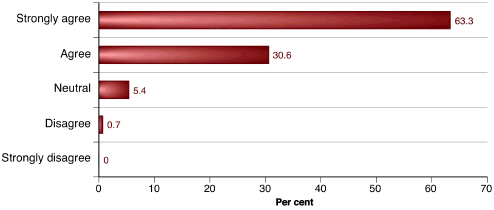
Source: VCOSS/Allen Consulting Group survey 2008.
Most organisations participating in the 2008 survey attributed the growing demand for services to the growing complexity of clients' needs. Stakeholders said employees were dealing with more complex issues than before, and the increasing pressure was being exacerbated by insufficient funding.
Growing complexity was seen to be a product of the ageing population and increases in mental health issues and drug and alcohol abuse.
As NFP organisations had trimmed administration personnel, managers were spending more time doing administrative work and thus had less time to participate in strategic activity, even though this is what the increasingly complex environment required.
While there are other factors influencing the demand for services, it is clear that the worsening economic environment will further exacerbate the demand for services over the next year or two.
Our research for this report also indicates that NFP organisations expect demand to increase even further in the year ahead. According to our survey results, eighty-three per cent of respondent organisations expect demand for services to increase over the next financial year (2009-2010).
Box 2.1
Summary of Recent Reports from Not-for-Profit Organisations about Demand for Services
Demand for services was already high before the economic downturn. As the following two examples show, the global financial crisis has resulted in further strain on not-for-profit organisations and the demand for services.
The Salvation Army expects that the economic downturn and resulting unemployment will mean more people in poverty, who in turn, will seek crisis services offered by organisations such as theirs. The Salvation Army currently assists over one million Australians who are in crisis each year. It anticipates more Australians in crisis over the next 18 months and is seeing some business people, who were previously donors, now needing their services and feeling 'overwhelmed by their debt levels'.
Research released in May 2009, that included a survey of 1,500 people who attend one of the Salvation Army's 40 centres, showed that many are worse off as a result of the economic downturn and pessimistic about the outlook for the next year. About half of those surveyed were unemployed.
Key findings include:
- 60 per cent of those surveyed believe they are 'worse off' or 'a lot worse off' as a result of the economic downturn;
- more than 40 per cent are 'pessimistic' or 'very pessimistic' about the year ahead;
- 22 per cent say they have experienced new family conflict as a result of their worsening financial situations;
- 54 per cent feel stressed or depressed about their situation; and
- 53 per cent have cut down on basic necessities and 58 per cent say they have cut down on luxuries.
VicRelief Foodbank reports that anecdotal evidence from some of its Melbourne-based agencies shows that there are a number of people who would be described as financially disadvantaged and seeking services as a result of credit debt. VicRelief Foodbank says 'this is a previously unknown cohort of people...- one which has presented increasingly over the past 12 months.'
Source: The Salvation Army 2009; VicRelief Foodbank 2009.
2.5 Staff and volunteers
Not-for-profit organisations, for the most part, are not making significant changes to staffing levels. NFP organisations appear to be absorbing staff cuts and looking to do 'more with less' or focusing on use of more part-time staff.
There are a number that have reported redundancies as a result of the economic downturn. As an example, Red Cross has made changes to its fundraising strategy and had to cut and realign staff positions, and Starlight Children's Foundation Australia has had to cut staff due to significant falls in funding (see Box 2.2).
Box 2.2
Examples of Staff Reductions in the No-for-Profit Sector
An example of some recent announcements by NFP organisations include the following:
- The Red Cross announced it will cut 20 jobs as part of an overhaul of its fundraising and communications, that currently employs around 110 staff. Changes to its fundraising strategy have resulted in the organisation looking to realign its staffing levels. A further 50 jobs are expected to be cut with staff needing to reapply for the new positions. (Klan 2009)
- Starlight Children's Foundation Australia has reportedly cut 20 staff, out of 150 positions and looking to make significant cuts to services due to falls in corporate and event fundraising. In an emergency appeal letter, the Foundation's CEO said the organisation was 'facing an unprecedented financial crisis' and facing significant cuts to services. The organisation has forecast a drop of $2 million in revenue this financial year. (Klan2009; Starlight Children's Foundation 2009)
Source: Klan 2009; Starlight Children's Foundation 2009;
In response to our survey, over half to two-thirds of respondents report no change in full-time, part-time or volunteering staff. A quarter of respondents have seen a decrease in full-time employees and 18 per cent have seen an increase. Only a few have seen any significant increases or decreases.
The survey results of paid employees in administrative, field and head office areas are varied. While 22 per cent report a decrease in paid administrative staff, the results are mixed for paid field employees (15 per cent report an increase and 15 per cent report a decrease) and for paid staff employed at head office (21 per cent report an increase and 20 per cent report a decrease).
In terms of part-time employees, 22 per cent of NFP organisations report an increase in the 2008-2009 financial year. When analysing these results further, there does not appear to be any obvious trends. While some not-for-profit practitioners who participated in focus groups indicated a shift from full-time to part-time staff, this was not evident from the survey results.
While 63 per cent report no change in volunteer numbers, a further 28 per cent have experienced an increase. There may be some shift to further reliance on volunteers. However, this also reflects the view that there are more people volunteering, either as a result of changes to employee volunteer programs (companies encouraging staff to utilise downturn for volunteer purposes), or an increase in availability of volunteers because of company redundancies and unemployment.
Figure 2.9 illustrates changes to staffing levels as a result of the economic downturn, as well as expectations for the next financial year.
Figure 2.11: Impact of the Economic Downturn on Staff Current Impact
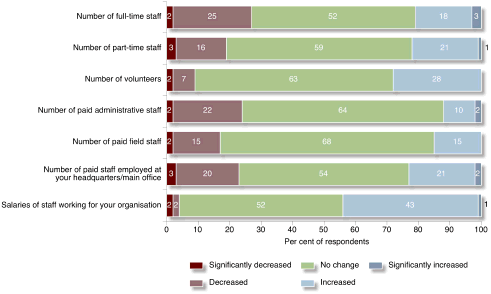
Expectations for Next Financial year (2009-2010)
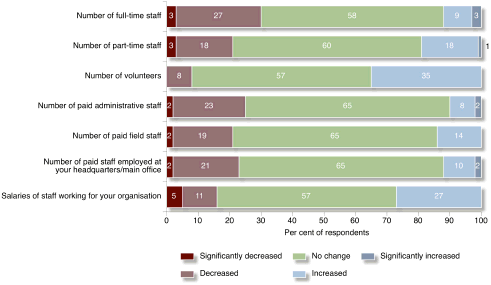
Source: Centre for Corporate Public Affairs, Survey of NFP organisations 2009. N=70.
NFP organisations report that demands on their employees have increased as a result of the economic downturn. For example, one NFP reported that staff now need to spend more time completing grant applications to meet the increase in service demand.
There is also more pressure from corporate partners and major donors to provide further justification of the partnerships and explanation of benefits. And NFP organisations report that they are spending more time meeting with donors in order to discuss the challenges facing their organisations. According to one NFP:
We are making sure our senior management team, board members and so on, are sitting down with major donors one day a month. So we are increasing face time.Many NFP organisations expect no staff change for the year ahead (see Figure 2.11). However, 27 per cent are anticipating a decrease in full-time staff. And 35 per cent expect an increase in volunteers.
This suggests that as NFP organisations continue to reduce costs for their organisations, full-time staffing costs will continue to be under review. A reliance on more volunteers to deliver services appears to be a more cost-effective measure during difficult economic times. This will put further strain on many NFP organisations.
Salaries of NFP staff have increased in recent times. We expect this is partly explained as a lag effect on budgets, as NFP organisations reported that they have had to increase salaries in recent years to attract staff to the sector. Just over half of NFPs surveyed say there has been no change, however, 43 per cent report an increase in staff salaries. For the year ahead, 58 per cent of NFPs expect no change. Twenty-seven per cent expect an increase in employee salaries, while 11 per cent anticipate a decrease.
In a separate survey question about training, 43 per cent of NFP organisations agree or strongly agree that in reaction to economic downturn, they have reduced training and professional development. A quarter reported a neutral response (i.e. no change) and 32 per cent disagreed that there has been any reduction.
Volunteers
As noted earlier, there has been an increase in the numbers of volunteers wanting to assist NFP organisations as a result of the economic downturn. NFPs attending focus groups report continued strong demand for volunteering opportunities. Not-for-profit organisations feel that they need to gear up for volunteers and create better volunteering opportunities. Corporate volunteer programs continue to place demands on not-for-profit organisation resources.
Some NFP organisations report that they are less able to support volunteer opportunities, a finding consistent with research into Victorian NFP organisations (Department of Planning and Community Development 2009a).
Volunteering centres are seeing a pick-up in demand from 'first-timers' who are volunteering and looking to complete volunteer courses. Some NFP organisations report they maintain waiting lists of volunteers. The Centre for Volunteering NSW reports it has been overwhelmed by volunteers - from people who are newly unemployed, to university graduates who are keen to contribute to the community and keep their skills relevant during the economic downturn (Horin 2009).
Twenty-eight per cent of NFP respondents to our survey report an increase in volunteer demand, and 35 per cent expect this to continue in the next financial year.
Box 2.3
Snapshot Of Victorian Not-For-Profit Organisations And Their Capacity To Manage The Impact Of The Economic Downturn
In 2009, the Office of the Community Sector in the Department of Planning and Community Development (Victoria) commissioned research on Victorian NFPs and their capacity to manage the impact of the economic downturn. Two short surveys were conducted with the same group of 18 not-for-profit community organisations, across a broad range of sectors. Following is a summary of the main findings.
January 2009 survey findings:
- 72 per cent report an increase in demand for services, mainly due to rising unemployment and increased financial stress in Victorian communities. Some of the other reasons included 'increased family violence', 'increased family breakdown' and 'reduced services from other organisations'. One respondent indicated an increase in referrals from other NFPs and government agencies such as Centrelink.
- 67 per cent report a decrease in funding, mainly due to falls in investment portfolios and donations.
- Strategies for managing the downturn include reviewing financial positions, evaluating programs and activities to assess what can be cut or deferred, collaborating with other NFP organisations, and having open dialogues with stakeholders and funders about the impact of the downturn. Victorian NFPs say they are also implementing strategies to ensure sustainability and considering collaborating with other NFPs.
- Half report that staff levels were unchanged, 16 per cent report a decrease and 33 per cent report an increase over the previous year. Others report a reduction in hours and freezing of positions. Volunteer participation appears to be stable.
The findings of the April 2009 survey illustrate that the impact of the economic downturn has intensified for Victorian NFPs. Note that the Victorian bushfires also occurred and put further pressure on some NFPs. For some organisations it has resulted in an increase in demand for their services, while for others there appears to have been some diversion of funds to support those affected by the bushfires.
Since the January 2009 survey:
- 65 per cent of NFPs surveyed report a change in their financial situation since the three month period. Of those, the majority reported a decline due to the economic downturn. Again, declines in investment portfolios (reported by 90 per cent of NFPs) and donations were contributing to their overall declines in income. Half of NFPs surveyed said that corporate sponsorships and philanthropic grants had also fallen over the January to April period.
- Most NFPs also reported an increase in demand for services, again due to increased financial stress in Victorian communities, increased unemployment and less services provided by other organisations. Financial pressure and anxiety was also a factor in increased demand for services. One respondent commented that homelessness was increasing among aged and unemployed which was creating additional demand.
- There were mixed results on staffing numbers, as some NFP organisations had made cuts, and others had increased staffing levels to cope with increased demand. Some Victorian NFPs report an increase in volunteers.
- Strategies to manage the impact of the economic downturn remained similar. However, there was an increase in NFPs that were implementing strategies to maintain sustainability, as well as considering other opportunities that might be available for their organisation. NFP organisations may have been more concerned in January as there appears to be much lower responses to many areas that were being cut in that month, including existing programs and new programs, as well as staff training and hours.
Source: Office for the Community Sector, Victorian Department of Planning and Community Development 2009a and 2009b.
2.6 Other influences or changes that are currently affecting not-for-profit operations
While this report focused on research on the impact of the economic downturn on NFP operations, we also assessed whether there were other significant influences or changes that were affecting NFP operations.Following are some of the responses to an open-ended survey question about these other influences or changes:
- increases in demand for services over past years, but core funding from government has remained unchanged;
- burnout of highly skilled employees continues to be an issue for the sector;
- diversion of funds to Victorian bushfires and other disaster relief;
- loss of government tenders and contracts has impacted on ability to provide community services as profits generated were used to support these services;
- decrease in capability to access available philanthropic funds;
- increased borrowings for existing projects;
- withdrawal of government funding;
- high rents for commercial space; and
- complexity and bureaucracy in dealing with government-required governance.
Chapter 3 Impact of the economic downturn on relationships between not-for-profit organisations and stakeholders
3.1 Introduction
There is a wide spectrum of relationships between NFP organisations and the various groups that partner with and support them. They range from deeply embedded, longer-term partnerships to more transactional relationships .As part of the research for this report, survey and focus group participants were asked about the impact of the economic downturn on their relationships with the key stakeholders who provide support to their organisations.
In this section of the report the stakeholders are divided into five groups:
- business;
- philanthropic trusts/foundations;
- major donors (such as philanthropic individuals);
- governments; and
- the community.
As indicated in Figure 2.6, NFP organisations are spending more time managing relationships with their partners.
Practitioners consulted for this report say they are having honest conversations with partners about the impacts of the economic downturn, with the aim of understanding each other's priorities during this time. Research with Victorian NFP organisations also suggests that 'open dialogue with key stakeholders and funders' was a strategy that organisations were implementing in response to the downturn (Department of Planning and Community Development 2009a).
3.2 Relationships with business
Relationships with businesses have been affected to varying degrees by the economic downturn. In some cases, the impact has been significant, illustrated earlier in this report by falls in corporate support and ability of some companies to support NFP partners.Sixty-eight per cent of respondents to our survey said that the priorities of their business partners were changing. Seventy-five per cent said their business partners were re-evaluating their community partnerships as a result of the crisis.
NFP organisations with longer-term integrated partnerships, or dynamic and sophisticated relationships with businesses, report that these agreements and contracts are being renewed. However, there is concern whether these renewals will continue over the next few years.
As illustrated in Figure 3.2, although contracts and long-term understandings and agreements are being reviewed, it does appear for the most part that contracts are being honoured. Just 4 per cent of NFP organisations surveyed say that their contracts are not being honoured.
One NFP commented:
Corporates seem to take longer in the decision making process surrounding sponsorship engagement. [There is] a sense of calculated cautiousness in the marketplace.We note that in the Centre's report on Impact of the economic downturn on corporate community investment (2009) that companies are, for the most part, renewing their partnership agreements.
That report focuses on the top 120 companies operating in Australia that typically have longer-term partnerships as part of their community investment.
In the survey for this report, not-for-profit organisations commented on their relationships with business, including larger companies, as well as small and medium enterprises. We expect that smaller to medium enterprises are more likely to be in the transactional or philanthropic stage of community investment, and are more likely to review their community investment relationships during the economic downturn. Companies and NFP organisations that are in the integrative stage of community investment are less likely to review their commitments. These three stages of business/NFP relationships are illustrated in Figure 3.1.
Figure 3.1: Three Stages of Business and Community Collaboration
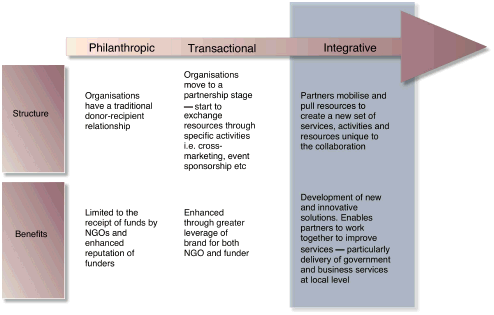
Source: James Austin 2002.
There appears to be some shift towards short-term funding, with some NFP organisations reporting that their business partners have moved from three-year contracts to shorter one-year commitments. Our consultations with business also suggests this may be the case. In our survey, 41 per cent of respondents noticed a shift towards short-term priorities and funding with their business partners.
Smaller not-for-profit organisations seem to be affected seriously more so than larger NFP organisations. One Melbourne-based NFP in consultations said:
Corporates have begun to re-think who and how they fund. Many are going back to traditional big charities rather than small ones. Big ones have cash flow - so do not need that support. Small ones need it as we are in start-up mode. We have really felt the impact of corporates walking away. We have to rethink our fundraising strategy as a result.Not-for-profit organisations with contracts or agreements with companies report that they are in a better position than those without. That said, there is a general feeling that corporations could 'walk away' at any time.
Figure 3.2: Impact on Business Relationships
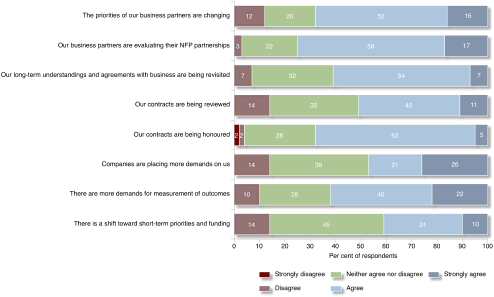
Source: Centre for Corporate Public Affairs, Survey of NFP organisations 2009. N=59.
Survey respondents report that companies are placing more demands on them, particularly requiring further explanation of the benefits of funding relationships and measurements of outcomes.
Nearly half (47 per cent) agree that companies are more demanding (21 per cent 'agree' and 26 per cent 'strongly agree'). Sixty-two per cent of NFP organisations point to an increase in demands for measurement of outcomes as a result of the economic downturn.
As there is a general trend toward greater accountability, it is difficult to know to what extent the economic downturn is the cause of this change. However, this has greatly added to the demands on NFP practitioners' time, as they need to spend more effort on managing their relationships with businesses. Ideally, they would prefer to be spending time on increasing fundraising efforts and managing the delivery of services within an environment of resource constraints.
Many NFP organisations consulted in focus groups were concerned with retaining their relationships with business, even if funding was reduced significantly. Most were taking the long-term view that it was important to retain contacts with key partners so that after the crisis, they would have the benefit of the partnership.
There was some sense of confidence in this regard - a belief that in a few years they would be able to resume their strong relationships with business.
NFP organisations also express understanding of the challenges that their business partners face (see Figure 3.3). Conversely, one quarter of the NFP organisations surveyed for this report said business partners do not understand their challenges. Fifty-nine per cent 'agree', however, that businesses do understand their challenges.
Figure 3.3 illustrates other impacts of the downturn on NFP-business relationships, including:
- 46 per cent of NFP organisations believe companies are more focused on achievement of societal outcomes and the longer-term impacts of the programs and activities;
- 55 per cent of NFPs report there are more constraints on use of funding for overhead and administration costs (31 per cent 'strongly agree');
- 55 per cent of NFPs say there is more communication with business partners. However, interestingly, there has been no major decline in the level of trust in the relationships - only 9 per cent of those surveyed think there is less trust;
- 61 per cent believe overall that there are more partnership issues to be dealt with as a result of the economic downturn; and
- there are mixed results in terms of working with business partners to manage uncertainties: nearly a quarter are working closely with business; another quarter say they are not working closely with their business partners to manage uncertainties.
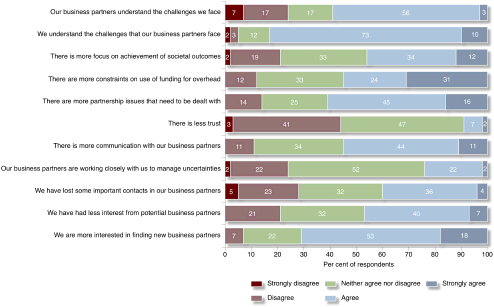
Source: Centre for Corporate Public Affairs, Survey of NFP organisations 2009. N=59.
Many NFP organisations are pursuing new business partners to ensure more diversity in their funding base, and to establish relationships that can develop in the future. Forty per cent of survey respondents say they have lost some important business contacts, while 47 per cent report less interest from potential business partners.
Other NFP organisations note they are more proactive about their relationships. For example, some were actively pursuing new ways to interact with business partners. They were also asking current partners to introduce them to other potential new supporters.
There is recognition that NFPs and businesses needed to be more frank with each other. One NFP reported it was beginning to have more 'honest conversations' with its business partners, and working together wherever possible to help its business partner meet sales/service targets.
Several NFPs indicated in consultations that they were spending more time executing marketing and brand management on behalf of their business partners. They said that it was commonplace now for them to undertake marketing and promotion that benefited their business partners.
In consultations, one NFP organisation said it was under marketing pressure:
We have to show bang for buck, and this is illustrated through our ability to get them a profile. What ends up happening is that we get diverted from our core business because we end up doing marketing and communications for a major corporate, and hoping this will be enough.However, this appears to be an exception. Most NFPs report that they are adhering to core business.
Changes in corporate support
There are some interesting changes in the nature of corporate support as a result of the economic downturn. Around a third of NFP organisations report an increase in community activity support, marketing-related sponsorships and availability of corporate volunteers. Just over a quarter have seen an increase in cause-related marketing.
The major area of decline in corporate support has been untied cash donations. Forty-nine per cent of NFP organisations reported a decrease or significant decrease. Twenty-two per cent report a decline in marketing sponsorship, and 23 per cent point to a decline in workplace giving and payroll deductions.
Figure 3.4: Change in Corporate Support - This Financial Year (2008/09) Compared with Last Financial Year
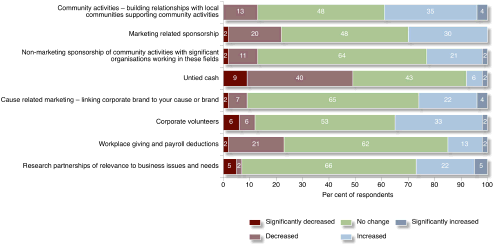
Source: Centre for Corporate Public Affairs, Survey of NFP organisations 2009. N=56.
These results vary according to sectors. As noted earlier, it appears that the arts and sports sectors have more business support withdrawn compared to other sectors.
NFP organisations in the environment sector observe that businesses appear to be more committed to their cause and to longer-term relationships, and are unlikely to cut ties at this critical time.
Employee engagement is also a likely driver of continuing relationships with environment focused NFP organisations.
One environment NFP commented:
We don't see cuts happening where there are specific programs that involve staff or have very specific outcomes.As we have noted earlier also, there is some shift away from monetary support of NFPs to provision of in-kind support. Some companies are looking for more innovative ways to support their community partners. According to one NFP:
More companies are looking to fundraise for us rather than investing up-front.Some events such as charity balls, which have struggled to sell tickets to corporate and major donors over the past year, are struggling to find support. Some NFP organisations are changing their focus for such events, while others have cancelled their fundraising balls for this year.
One NFP commented:
Corporations can't be seen to be involved in these things. Taking a table at a ball is not a favourable thing to do.NFPs anticipate that in the forthcoming financial year (2009-2010), cause-related marketing (linking corporate brand to cause or brand) will increase, along with marketing related sponsorships. Corporate provision of untied cash is expected to continue to decline over the next year. Expectations for corporate support in the next financial year is illustrated in Figure 3.5.
One NFP commented:
The challenge for the next year is whether the economic downturn will have hit corporates more over the next year. We expect a few not to renew next year.Figure 3.5: Expected Change in Corporate Support for Next Financial Year (2009-2010)
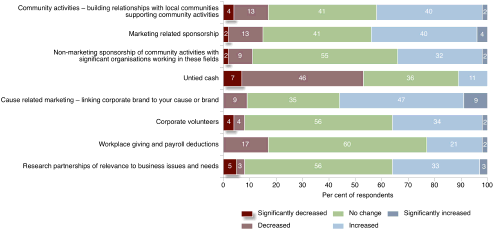
Source: Centre for Corporate Public Affairs, Survey of NFP organisations 2009. N=56.
3.3 Relationships with philanthropic trusts, foundations and major donors
As with corporate partners, NFP organisations report that there are more issues with their relationships with major donors, philanthropic trusts and foundations. Priorities are often changing and many donors and partners are reviewing their relationships.There is concern that NFPs will continue to struggle to attract new funding from their partners. The Australian Government is planning to review requirements for prescribed private funds, which may impact funding and major donors.
Philanthropic trusts and foundations
About 42 per cent of respondents to our survey indicated that funding from philanthropic trusts and foundations had decreased in the last year. This suggests a significant change in support from the philanthropic trusts and foundations sector.Thirty-eight per cent said their priorities were changing, and 61 per cent of NFP organisations surveyed said their philanthropic trust and foundation partners were reviewing their funding. Just over one quarter indicated there was a shift to short-term priorities and funding.
Respondents to the survey underpinning this report say that as a result of the economic downturn, there is more uncertainty in dealings with philanthropic trusts and foundations. Not-for-profit organisations also report that they are losing some important contacts with philanthropic trusts and foundations, and that there is less interest from potential partners.
Figure 3.6: Relationships with Philanthropic Trusts and Foundations
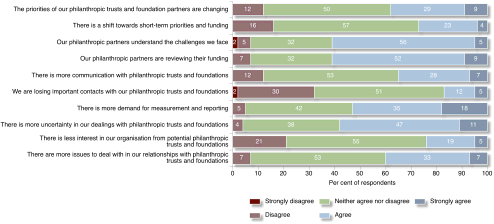
Source: Centre for Corporate Public Affairs, Survey of NFP organisations 2009. N=58.
During consultations, some not-for-profit organisations reported that they had lost more funding from overseas foundations with which they had long-term relationships. This appears to be the case with US-based foundations rather than Australian foundations. There are also other foundations that are scaling back commitments, and focusing on longer-term relationships, rather than other discretionary and one-off grants (Department of Planning and Community Development 2009a).
Major donors
As with philanthropic trusts and foundations, not-for-profit organisations are concerned that the priorities of their major donors are changing, and that these primary donors are reviewing their funding. They also note that there were more issues with which to deal, more uncertainty in their relationships with donors, and more demand for measurement and reporting.Figure 3.7: Relationships with Major donors
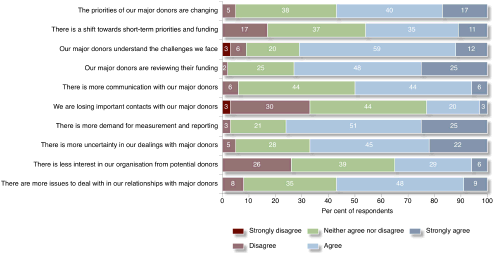
Source: Centre for Corporate Public Affairs, Survey of NFP organisations 2009. N=66.
Several NFPs noted that support from philanthropic individuals had remained strong, despite the economic downturn, and some donors were considered to be very reliable given their personal attachment to organisations that they had supported over the long term.
There are some instances of major donors increasing their funding commitments as they recognise that needs are greater during economic downturns. There was a general view that individuals were more reliable supporters than companies, if the NFP organisation can establish a personal connection to a cause.
Some NFPs mentioned that any delay in funding from major donors was temporary, rather than a long-term shift. One NFP commented:
We also have philanthropic individuals who support us well and they are tending to stay. One or two walked away but the majority have stuck with us. A few who were sniffing around the edges have put it on the back burner. Individuals are postponing their giving but not ruling us out.
3.4 Relationships with governments
Not-for-profit organisations report that they have increased the level of communication with government, including through increased reporting, more regular meetings and building stronger alliances with similar agencies to ensure their voice is heard.One large not-for-profit noted that the Federal Government had met most of its demands for additional support because of the economic crisis. In its view, the Government was cognisant of the need to spread its stimulus spending in the community sector, as well as through other parts of the economy.
Another NFP suggested Federal Government bonus payments in its two stimulus packages had resulted in some donors directly passing their individual stimulus contribution to NFP organisations.
As noted in the section on funding, some NFP organisations have applied for additional emergency government funding, and are awaiting the results of this funding round.
The Federal Government's responsiveness was expressed by one NFP as follows:
We put the argument to the Prime Minister late last year...that the sector needed a great deal of money to ride out the downturn. They made a provision very close to this.Research with Victorian NFPs also highlights the role of government in ensuring sustainability of the sector, with 80 per cent of those surveyed indicating they were seeking further government support to maintain sustainability (Department of Planning and Community Development 2009a).
In our survey, the majority of respondents agreed that the priorities of governments are changing - 49 per cent 'agree' with the statement and 29 per cent 'strongly agree'.
In particular, respondents noted that there was more focus on reporting and monitoring of agreements, program reviews and on outcomes of collaboration. Sixty-one percent felt there was more 'bureaucracy' as a result of the economic downturn. Thirty-eight per cent of NFP organisations also feel that governments do not understand the challenges they face.
Figure 3.8: Relationships with Government
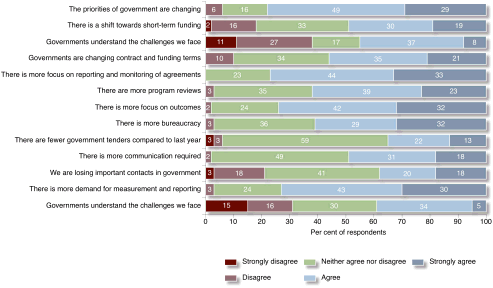
Source: Centre for Corporate Public Affairs, Survey of NFP organisations 2009. N=63.
3.5 Relationships with the community
Most NFPs had not experienced a significant downturn in community giving as a result of the global financial crisis. Of the survey respondents, 43 per cent believe there had been no change to fundraising through membership fees, online donations, regular giving and event fundraising in the past financial year. Thirty-two per cent note that giving had decreased, and 25 per cent say it has increased (see Figure 2.1).According to one NFP:
Donations are down...we have not had any big donations over the last six months.There appears to be some shift in donor ability to donate, for example, by retirees, who have seen declines in their superannuation and investment income.
Some NFPs consulted in the focus groups felt the crisis had increased giving because some Australian families were relatively better off. It was perceived that Australians who remained employed through the downturn were now enjoying very low interest rates, and many have also received two Government stimulus payments. These two factors enabled some families to give more than they did last year. There was also an awareness that many others were not doing as well, thus Australians were feeling more inclined to give.
One NFP commented:
On the general donation front, our experience from previous recessions is that the number of donations drop, but the average dollar value of donations goes up.During consultations, several NFPs noted that giving for the Victorian bushfire relief efforts had increased total giving. It has been noted in other research that one-off giving often led to increased patterns of giving, as with levels of giving following the December 2004 tsunami (McGregor-Lowndes and Newton 2009; Pro Bono Australia 2005).
Some NFP organisations believe there could be a similar trend following the surge of giving for Victorian bushfire relief initiatives. These large, emotive relief efforts often introduce community members to the concept of giving, and in many cases, people commit to ongoing giving.
Not-for-profit organisations appear confident that funds raised through the community were unlikely to fall dramatically in next financial year. Of the survey respondents, 41 per cent anticipated no change in funding from membership fees, online donations, regular giving, and event fundraising, 34 per cent anticipated an increase and only 25 per cent anticipated a decrease (see Figure 2.3).
3.6 Characteristics of sustainable relationships
The preceding section describes the impact of the economic downturn on not-for-profit relationships with key partners.
As we noted, some NFP organisations appear to be more heavily impacted by the downturn than others. Some have experienced a significant erosion in the nature of their relationships, and in some cases, a loss of corporate or philanthropic partners.
Others reported that the downturn has had no impact on their relationships or funding, and even offered additional opportunities to strengthen partnerships and funding relationships.
Understanding the characteristics of sustainable relationships will assist not-for-profit organisations better weather this downturn, and future economic downturns.
Our survey results and focus groups offered four key insights (outlined in Box 3.1) into what makes relationships and partnerships more durable, particularly in difficult economic times.
Box 3.1
- Not-for-profit organisations that communicated frequently with partners and had strong relationships were more likely to retain partnerships, even if funding commitments diminished for several years. The depth and number of contacts with the partner organisations also builds 'stickiness' and ensures relationships continue even if key contacts leave.
- Not-for-profit organisations with formal contracts with corporations, philanthropic trusts, and individuals appeared to fare better in the downturn, as it was less likely a formal contract would be broken relative to an informal agreement. These contracts or agreements typically cover mutually agreed goals, governance arrangements, joint decision-making, open communication and other elements of importance to the partnership.
- Not-for-profit organisations with more diverse relationships and partnerships were better off, because they were able to continue providing services if one partner broke ties. Reliance on one or a few major partners is a risk as a change in priorities can have a sudden impact on the funding for the NFP and therefore the ongoing provision of services.
- Not-for-profit organisations that have deep connections in communities and are willing to collaborate with other organisations in order to deliver services also appear to fare better during economic downturns. A willingness to be flexible in delivering services with other peer organisations with similar values ensures some sustainability with programs. Deep connections to the community also resonates with many corporations that look to support their local communities, particularly during economic downturns.
- Not-for-profit organisations with a majority of government funding appear to be better off as governments are less likely to cut funding, and could potentially increase funding in response to any increased need. However, reliance on government funding is also a risk, as this funding is not always ongoing and government priorities also change. NFP organisations that aim for a diverse range of partners and funding arrangements, including with government, appear to fare better during a downturn. [In the Centre's report Relationship Matters, we indicated that NFP organisations often seek partnerships with corporations to secure a more reliable funding source. It appears that the economic downturn has temporarily placed government ahead of corporations as a preferred source of funding given that government funding appears less likely to be cut during a downturn.]
Source: Centre for Corporate Public Affairs, survey and focus group summary.
These align with many of the same characteristics of successful partnerships that the Centre for Corporate Public Affairs (2008) identified in its research on not-for-profit operations. These include:
- open communication - establishing mutual trust, as well as anticipating and preventing problems;
- commitment - of time and funding; and
- ongoing learning, adaptability and flexibility - allowing programs to evolve and the partnership to grow organically.
Chapter 4 Opportunities
4.1 Potential opportunities
While the global financial crisis has had an adverse impact on many parts of the community, it has also yielded some opportunities for not-for-profit organisations and their partners.Survey respondents identified that two key opportunities were an increased focus on good governance and management of risks and reserves (67 per cent), and increased engagement with Boards on financial management and strategy planning (59 per cent).
Other opportunities identified were the ability to:
- strengthen relationships with existing loyal partners;
- raise awareness of certain issues (homelessness, poverty, training);
- recruit staff with various skills, and;
- increase demand for services providing the opportunity to expand.
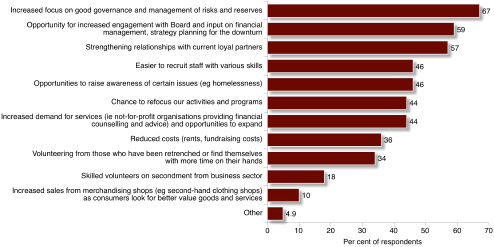
Source: Centre for Corporate Public Affairs, Survey of NFP organisations 2009. N=61.
A recent survey of charities in the UK also highlighted similar opportunities emerging from the economic downturn (PWC et al 2008). The positive impacts identified were a focus on good governance, opportunities for increasing awareness, opportunities for recruitment of key staff and increased availability of volunteers, reduced costs in some areas (such as office accommodation), and (for some not-for-profits), an increase in income (such as from charity shops).
In addition to these, not-for-profit organisations noted that as more people were unemployed, the pool of available volunteers grew also (as noted in Section 2.5).
We understand that some businesses and NFP organisations are also examining secondment opportunities, whereby business would 'offer' employees an opportunity to work within a NFP organisation instead of having to cut 'excess' staff. These secondment opportunities may involve partial payment of salaries by the business and NFP, or some other arrangement.
Some not-for-profit organisations noted there may be opportunities to merge with other peer organisations to reduce duplication. Similarly others note opportunities to forge partnerships with other not-for-profit organisations.
There was also a view that they may receive more funding to carry out certain services. For example, several NFP organisations noted that funding from government had increased for financial literacy programs to help people cope with the stimulus package.
Some organisations also noted that the economic crisis provided the opportunity to maximise the community's understanding of the real value of the NFP sector to the community.
One survey respondent described the situation thus:
This sector over-delivers to the point where its contribution is undervalued and often taken for granted. 2010 is a golden opportunity to leverage and maximise understanding of the real value of the sector to the community.Expectations for the 2009-2010 financial year reflect current feelings about opportunities arising from the crisis.
Survey respondents expect to see more opportunities for strengthening relationships with existing partners as well as increasing engagement with their Board.
The downturn also provides an opportunity to refocus activities and programs and focus on good governance. It also offers an opportunity to raise awareness about certain issues. NFP organisations that have been able to raise awareness about issues such as homelessness are seeing the benefits of increasing funding for sectors that are heavily impacted during economic downturns.
Figure 4.2: Likelihood of Not-for-Profit Organisations Benefiting from these Opportunities in the Next Year
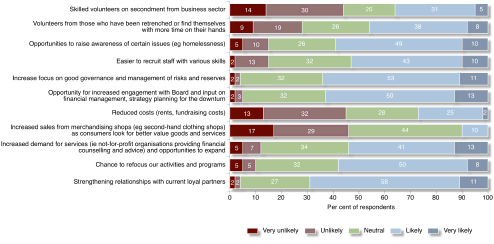
Source: Centre for Corporate Public Affairs, Survey of NFP organisations 2009. N=65.
Appendix A References
- ABS 2009 'Not-for-profit Organizations, Australia, 2006-07' (Re-Issue), viewed 18 June 2009, <http://www.abs.gov.au/upstarts/abs@.ns/Latest products/8106.0Main%20Features12006-07%20(Re-Issue)?open document&tab name=Summary&prod no=8106.0&issue=2006-07%20(Re-Issue)&numb=&view=>.
- Access Economics 2008, The impact of the global financial crisis on social services in Australia, November 2008, Report to Angelica Australia, Catholic Social Services Australia, The Salvation Army and Uniting Care Australia
- Australian Council of Social Service 2009, Australian Community Sector Survey 2009, ACOSS Paper 157, Sydney.
- Allen Consulting Group 2008, 'How many wheelchairs can you push at once?' - Productivity in the community service organization sector in Victoria, December 2008, Report to Victorian Council of Social Service
- Austin, J 2002, 'Strategic Alliances: Creating For-Profit and Nonprofit Partnerships', Harvard Business School Leading Research, vol.3, no.4.
- Australia Business Arts Foundation (Abaft) 2009, Arts Sponsorship Outlook Survey 2009 - Summary of findings and recommendations, May.
- Centre for Corporate Public Affairs 2007, Corporate Community Investment in Australia, Centre for Corporate Public Affairs, Melbourne.
- Centre for Corporate Public Affairs 2008, Relationship matters: not-for-profit community organisations and corporate community investment, Centre for Corporate Public Affairs, Sydney.
- Department of Planning and Community Development (Office for the Community Sector) 2009a, Snapshot - Community and not for profit organisations' capacity to manage the impact of the Global Financial Crisis 2008/09, February, Melbourne.
- Department of Planning and Community Development (Office for the Community Sector) 2009b, Snapshot - Changes in community and not for profit organisations' capacity to manage the impact of the Global Financial Crisis 2008/09, May, Melbourne.
- Horin, A 2009, 'Meet generation V: the volunteers', Sydney Morning Herald, 9 June.
- Klan, A 2009, 'Donation drought forces Red Cross to sack workers', The Australian, 18 May.
- Lea, K 2009, 'Impact of the financial crisis on philanthropy - a cross sector analysis, Pro Bono Australia's NFP Newsletter, viewed 28 April 2009, <http://www.probonoaustralia.com.au/news/detail.chtml?filename_num=273340>.
- McGregor-Lowndes, M & Newton, C 2009, An Examination of Tax Deductible Donations Made by Individual Australian Taxpayers in 2006-07, Working Paper No. CPNS 45, May, Brisbane.
- PricewaterhouseCoopers LLP, Charity Finance Directors' Group and Institute of Fundraising 2008, Managing in a Downturn: November 2008 survey results, analysis and key messages.
- Pro Bono Australia 2005, 'Research on Post-Tsunami Fundraising', NFP Newsletter, viewed 16 June 2009, <http://www.probonoaustralia.com.au/news/detail.chtml?filename_num=112297>.
- Starlight Children's Foundation Australia 2009, 'Starlight Emergency Appeal Letter', viewed 16 June 2009, <http://www.starlight.org.au/News/Pages/StarlightEmergencyAppeal.aspx>.
- The Salvation Army 2009, 'Launch of Red Shield Appeal', viewed 18 June 2009, <http://www.salvationarmy.org.au/SALV/MEDIA/PC_62781.html>.
- VicRelief Foodbank 2009, Pushing the Boundaries of Hunger in Victoria, December 2008, Melbourne.
Appendix B Contributors
We would like to thank the following organisations for participating in this research study, either by attending focus groups in Sydney, Melbourne or Perth, participating in the online survey or meeting individually with the researchers.This list below includes those who provided their contact details on the online survey. There were many more not-for-profit organisations that participated who chose to remain anonymous.
- Alcohol and Drug Foundation ACT Inc
- Alcohol and other Drugs Council of Australia
- Alzheimer's Australia
- Anglicare SA
- Anglicare Victoria
- Autism Association of WA (Inc)
- Barnardos
- Bundaberg & Burnett Region Community Development Aboriginal Corp
- Canberra & Queanbeyan ADD Support Group Inc
- Canberra Multicultural Community Forum (CMCF) Inc
- Canteen
- Care Australia
- Clean Ocean Foundation
- Clean Up Australia
- Communicare Inc
- Concern Australia
- Conservation Council ACT Region Inc
- Conservation Volunteers Australia
- Country Arts WA
- Cure for Life Foundation
- DADAA Inc
- David Wirrpanda Foundation
- DRUG ARM Australasia
- Fairbridge Western Australia
- Fifteen Foundation Australia
- Foodbank of Western Australia Inc.
- Gasworks Arts Park
- Good Grief Ltd
- Griffin Theatre Company
- Inspire Foundation
- Juvenile Diabetes Research Foundation
- Kidney Health Australia
- Leukaemia Foundation of Australia
- Life Stream Foundation
- Lifeline WA
- Lions Australia
- Lismore Neighbourhood Centre Inc
- Melbourne Citymission
- Melbourne Community Forum
- Melbourne Community Foundation
- Milang Progress Association Incorporated
- National Breast Cancer Foundation
- Netball Queensland
- Nyoongar Patrol Night Patrols
- Odyssey House Victoria
- Older People Speak Out
- OzChild
- Patricia Giles Centre
- PQA/CMLA
- Princess Margaret Hospital Foundation
- Rainforest Rescue
- Richmond Community Services Inc
- Rockingham Regional Environment Centre (Inc)
- SAPH Vision Quest Association Inc.
- Scouts Australia, WA Division
- Scouts Victoria
- Shelter WA
- SHINE for Kids Cooperative Ltd
- SHOUT Inc (Self Help Organisations United Together)
- St Kilda Youth Service
- St Vincent de Paul Society
- The Australian Lung Foundation
- The Duke of Edinburgh's Award in Australia
- The Leukaemia Foundation
- The Shepherd Centre
- The Smith Family
- The Sport Australia Hall of Fame
- Try Youth and Community Services
- Variety WA
- Victor Chang Cardiac Research Institute
- Victorian Institute of Sport
- Wesley Mission
- WestAus Crisis & Welfare Services
- Western Australian Community Foundation
- YMCA Perth
- Youth Insearch Foundation
- YWCA
- YWCA NSW
Last updated:
